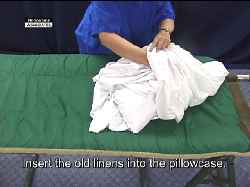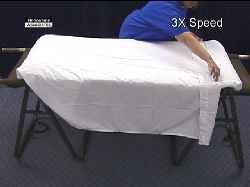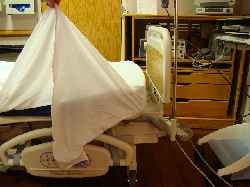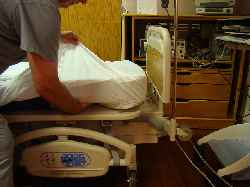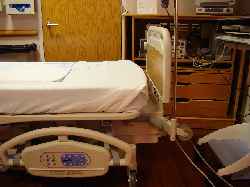|
2-1. INTRODUCTION
The patient care unit is the area of the hospital in which
the patient receives medical and nursing care and treatment as well as the
place in which he/she lives during his/her hospital stay. It must be
maintained as a safe, pleasant, clean, and orderly environment for the
patient's physical and mental well being. Constant effort is needed to
achieve and maintain the necessary high level of order and sanitation.
2-2.
FURNITURE COMPRISING
THE PATIENT BASIC UNIT
Furniture for the patient basic unit includes:
-
Bed.
-
Bedside cabinet.
-
Overbed table.
-
Chair.
2-3.
EQUIPMENT/ARTICLES NECESSARY FOR PROVIDING BASIC NURSING CARE
The following are provided to the patient:
-
Linens.
-
Bed linens.
-
Towels.
-
Washcloths.
-
Blankets.
Toilet Equipment.
-
Wash basin.
-
Soap dish.
-
Emesis basin.
-
Bedpan.
-
Urinal.
-
Toilet paper.
Other Articles.
-
Water pitcher.
-
Glass.
-
Call button.
-
Disposable facial tissues.
2-4. GUIDELINES FOR
BED-MAKING
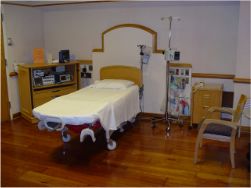
Hospital Bed Arrangement in
Labor and Delivery |
|
a. Gather all the required linen and accessories before
making the bed.
-
Sheets.
-
Pillowcases.
-
Blankets.
-
Bedspread.
-
Extra pillows.
b. Avoid shaking the linen to prevent the spread of
microorganisms and dust particles.
c. Avoid placing linens, clean or dirty, on another
patient's bed.
d. Do not place dirty linen on the floor.
e. Do not hold dirty linen against your uniform.
f. Always use good body mechanics; raise the bed to its
highest position to make bed-making easier.
g. Stay on one side of the bed until it is completely made;
then move to the other side and finish the bed. This saves time and steps.
h. Observe the patient and document any nursing
observations.
-
Check for areas of redness that may lead to decubiti
formation.
-
Note tolerance of activity level while out of bed.
-
Note observations about the physical and emotional status
of the patient.
-
Note any patient teaching or reinforced teaching given
and the patient's response.
-
Check for drainage, wetness, or other body fluids and
record observations.
2-5. METHODS OF BED-MAKING
Unoccupied (Closed) Bed.
An unoccupied bed is one that is made when not occupied by a patient.
-
Raise the bed to a comfortable working height, if
adjustable.
-
Lower siderails, if present.
-
Remove pillows and pillowcases. Set the pillows aside in
a clean area.
-
Fold and set the blankets and spreads aside (to be
reused).
-
Loosen the linen along the edges of the bed, and move
toward the end of the bed.
-
Wash the mattress if necessary, turn the mattress to the
opposite side if necessary, and replace the mattress pad as needed. Observe
the mattress for protruding springs.
-
Place the bottom sheet.
Flat sheet.
-
Position evenly on the bed.
-
Miter the corners at the top of the bed. Lift the mattress
slightly, then stretch and tie the ends of the sheet together beneath the
mattress. Repeat these steps for the bottom of the bed.
-
Stretch and tuck the free edges at the sides.
Fitted sheet.
-
Fit the sheet on the lower edges of the mattress first.
Then lift the mattress and fit the sheet on the top edges of the
mattress.
-
Stretch and tuck the free edges at the sides.
-
Place a draw sheet on the center of the bed, if it is
needed.
-
Place the top sheet, blanket (if used), and bedspread.
-
Position evenly on the bed.
-
Miter the bottom corners, tucking all three parts
together.
-
Leave the loose ends free.
Fanfold the top linen back to the foot of the bed.
Place a clean pillowcase over the pillow and place it
at the head of the bed.
-
Invert the pillowcase over one hand so the inner back
seam is visible.
-
Grasp the edge of the pillow with one hand holding the
pillowcase at the seam.
-
Use the opposite hand to guide the pillowcase over the
pillow.
Adjust the bed to its lowest position, if adjustable.
Reposition the head up slightly, if the patient
prefers.
Raise the siderail opposite the side of the bed where
the patient will enter.
Occupied (Open) Bed.
An occupied bed is one that is made while occupied by a patient.
-
Wash your hands.
-
Identify the patient, explain the procedure, and be sure
you will have the patient's cooperation.
-
Check the condition of the bed linens to determine which
supplies you will need.
-
Provide for the patient's privacy (throughout the
procedure).
-
Obtain the articles of linen that you will need.
-
Place the bath blanket over the patient and the top
cover.
-
Loosen the top bedding from the foot of the bed and
remove it. If possible, have the patient hold the bath blanket while you
pull the top covers from under it from the foot of the bed.
-
Move the mattress to the head of the bed.
-
Move the patient to the distal side of the bed.
-
Make the bed on one side.
-
Move or turn the patient to the clean side of the bed,
and finish making the bed on the opposite side. Place the clean linen on top,
and remove the bath blanket.
-
Attach the patient's signal cord within reach.
-
Provide for the patient's safety and comfort.
-
Tidy the room.
Anesthetic, Surgical, or
Post-Op Be. This is a bed that is prepared to receive a patient from the operating room.
-
Gather all needed supplies:
-
Make the bed as though you are making an unoccupied bed,
except that the top sheet and blanket are not tucked under the mattress
at the foot of the bed, and the corners are not mitered.
-
Fanfold the top covers to the side or to the foot of the
bed.
-
Place a towel or disposable pad (Chux ®) at the head of
the bed. This is intended to protect the sheet if the patient should vomit.
-
It is a good idea to place a drawsheet on the bed
because it can be used to move the patient more easily.
-
Place the pillow(s) on a chair near the bed or in an
upright position at the head of the bed.
-
Leave the bed in the high position.
-
Lock the brakes on the bed.
-
Move the furniture away from the bed to allow for easier
access to the bed for the recovery room stretcher and personnel.
-
Make certain an emesis basin is readily available and
suction is available where indicated.
-
Keep Chux ® available to use if necessary.
|
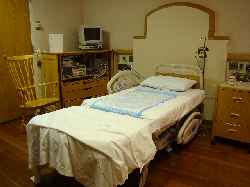
Bed in Low Position |
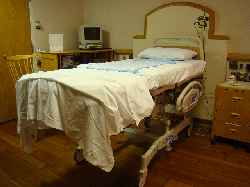
Bed in High Position |
|
|
|
2-6. TERMINAL CLEANING OF THE PATIENT CARE UNIT
Definition.
-
The sanitation of the bed, bedside cabinet, and general
area of the patient care unit with a detergent/germicidal agent after
the patient is discharged or transferred from the nursing care unit.
-
Performed at every patient care unit before the area is
prepared for the next patient.
Reasons for Terminal
Cleaning of the Patient Care Unit.
-
Prevention of the spread of microorganisms.
-
Removal of encrusted secretions from framework or
bedside rails.
-
Removal of residue of body wastes from the mattress.
-
Deodorizing of the bed frame, mattress, and pillow.
Guidelines for Terminal
Cleaning.
-
Review ward SOP for specific procedures.
-
Use only authorized disinfectant/detergent or germicidal
solution for cleaning.
-
Check to ensure the bedside cabinet is cleared of any
valuables belonging to the patient.
-
Check bed linens for personal items (dentures, contact
lenses, money, jewelry, etc.) belonging to the patient.
-
Prevent spread of microorganisms by carefully removing
linen from the bed.
-
Use caution when cleaning the underframe and bedsprings.
-
Replace any torn mattress or pillow covers.
-
Allow the mattress and pillow to air-dry thoroughly
before remaking the bed.
2-7.
RULES FOR USE OF DISPOSABLE OR NONREUSABLE ITEMS
-
Do not attempt to reuse (for another patient) or resterilize disposables.
-
Sterile disposables are considered sterile providing the
wrapper is not broken or torn or the expiration date has not passed.
-
Sterile disposables with torn or broken wrappers must be
discarded.
Continue with Exercises
The Brookside
Associates Medical Education Division is dedicated to the development and
dissemination of medical information that may be useful to medical professionals
and those in training to become medical professionals. This website is
privately-held and not connected to any governmental agency. The views expressed
here are those of the authors, and unless otherwise noted, do not necessarily
reflect the views of the Brookside Associates, Ltd., any governmental or private
organizations. All writings, discussions, and publications on this website are
unclassified.
© 2007 Medical Education
Division, Brookside Associates, Ltd. All rights reserved
Other
Brookside Products
Contact Us

Advertise on this Site
|
|


